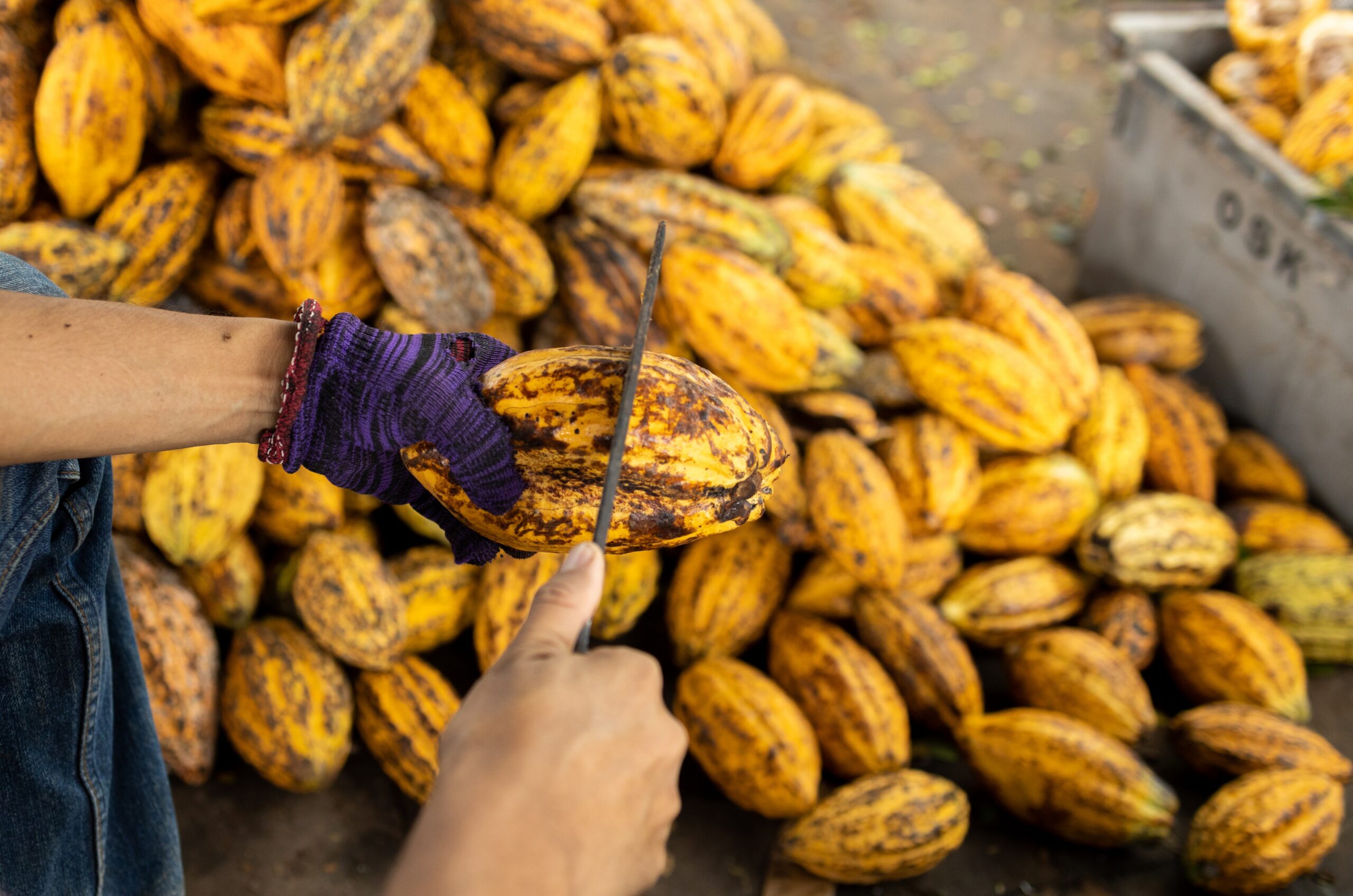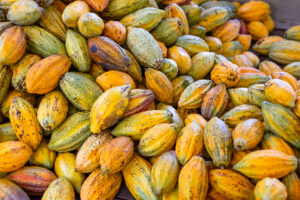If you’ve ever found yourself standing in the baking aisle, staring at two nearly identical tins of cocoa powder and wondering, “What’s the difference?”—you’re not alone. The world of cocoa powder can be a little confusing, especially when you’re trying to decide between natural and alkalized (also known as Dutch-processed) cocoa powder. Both come from raw cocoa beans, both are used to make delicious chocolatey treats, and both look pretty much the same at first glance. But trust me, they’re not interchangeable. So, what’s the difference between them? Why do some recipes call for one over the other? And which one should you choose when making chocolate, desserts, or even cocoa-based drinks?
Understanding the difference between these two types of cocoa powder can make or break your recipe. Whether you’re baking a cake, whipping up a batch of brownies, or making a rich hot cocoa, the type of cocoa powder you use matters. So, let’s break it all down
What Is Cocoa Powder, Anyway?
Before we dive into the differences, let’s start with the basics. Cocoa powder is made from raw cocoa beans, which are harvested from cocoa trees, fermented, dried, roasted, and then pressed to remove most of the cocoa butter. What’s left is a solid mass called cocoa cake, which is ground into the fine powder we know as cocoa powder.
Cocoa powder is a staple in baking and cooking because it packs a concentrated chocolate flavor without the added fat and sugar found in chocolate bars. But not all cocoa powders are created equal. Depending on how they’re processed, they can have very different characteristics.
Natural Cocoa Powder: The Pure, Unprocessed Option
Natural cocoa powder is exactly what it sounds like—cocoa powder in its purest form. After the cocoa beans are roasted and pressed, the resulting powder is left as-is, without any additional processing.
Key Characteristics of Natural Cocoa Powder
-
- Flavor: Natural cocoa powder has a strong, intense chocolate flavor with a slightly acidic or tangy taste. If you’ve ever tasted unsweetened cocoa, that sharp, almost bitter flavor is typical of natural cocoa powder.
-
- Color: It has a light brown color, which can vary depending on the type of cocoa beans used.
-
- pH Level: Natural cocoa powder is acidic, with a pH level of around 5 to 6. This acidity plays a big role in how it behaves in recipes.
-
- Color: Light brown to reddish-brown
-
- Taste: Strong, bitter, and slightly acidic
-
- Best Uses: Because of its acidity, natural cocoa powder works best in recipes that call for baking soda.
Because natural cocoa powder is acidic, it reacts with baking soda (which is alkaline) to create carbon dioxide. This reaction helps baked goods rise, making them fluffy and soft. That’s why recipes that use baking soda usually call for natural cocoa powder.
You’ll often find natural cocoa powder used in homemade chocolate cakes, brownies, cookies, and some hot chocolate recipes.
What is Alkalized (Dutch-Processed) Cocoa Powder?
Alkalized cocoa powder, also known as Dutch-processed cocoa powder, goes through an extra step where it’s treated with an alkalizing agent (like potassium carbonate) to reduce its natural acidity. This process gives it a smoother, milder taste and a darker color.
Key Characteristics of Alkalized Cocoa Powder:
-
- Color: Dark brown to almost black
-
- Taste: Milder, less bitter, and slightly earthy
-
- pH Level: Around 7 to 8 (neutral or slightly alkaline)
-
- Best Uses: Works well in recipes that use baking powder (like European-style cakes, ice creams, and hot cocoa)
Since alkalized cocoa powder is neutral in pH, it doesn’t react with baking soda. Instead, recipes that call for Dutch-processed cocoa often use baking powder to provide the leavening effect needed for rising.
You’ll often see alkalized cocoa powder used in European-style chocolates, premium hot chocolate mixes, ice creams, and dark chocolate cakes.
Natural Cocoa Powder: The Pure, Unprocessed Option
Natural cocoa powder is exactly what it sounds like—cocoa powder in its purest form. After the cocoa beans are roasted and pressed, the resulting powder is left as-is, without any additional processing.
Key Characteristics of Natural Cocoa Powder
-
- Flavor: Natural cocoa powder has a strong, intense chocolate flavor with a slightly acidic or tangy taste. If you’ve ever tasted unsweetened cocoa, that sharp, almost bitter flavor is typical of natural cocoa powder.
-
- Color: It has a light brown color, which can vary depending on the type of cocoa beans used.
-
- pH Level: Natural cocoa powder is acidic, with a pH level of around 5 to 6. This acidity plays a big role in how it behaves in recipes.
-
- Best Uses: Because of its acidity, natural cocoa powder works best in recipes that call for baking soda. The acid in the cocoa reacts with the alkaline baking soda to create carbon dioxide, which helps baked goods rise. Think fluffy cakes, chewy brownies, and tender cookies.
Why Choose Natural Cocoa Powder?
If you’re looking for a bold, intense chocolate flavor, natural cocoa powder is the way to go. It’s also the preferred choice for classic recipes like devil’s food cake or traditional brownies. Plus, it’s often less expensive than alkalized cocoa powder, making it a budget-friendly option for home bakers.
Alkalized Cocoa Powder: The Smooth, Mellow Alternative
Alkalized cocoa powder, also known as Dutch-processed cocoa powder, undergoes an additional step during production. After the cocoa beans are roasted and pressed, the powder is treated with an alkaline solution (usually potassium carbonate) to neutralize its acidity.
Key Characteristics of Alkalized Cocoa Powder
-
- Flavor: Alkalized cocoa powder has a smoother, milder flavor compared to natural cocoa powder. The alkalization process reduces the acidity, resulting in a less tangy and more rounded chocolate taste.
-
- Color: It has a darker, richer color—often a deep reddish-brown or almost black. This makes it popular for recipes where a dark, luxurious appearance is desired.
-
- pH Level: Alkalized cocoa powder is neutral or slightly alkaline, with a pH level of around 7 to 8. This lack of acidity changes how it interacts with other ingredients in baking.
-
- Best Uses: Because it’s not acidic, alkalized cocoa powder is ideal for recipes that use baking powder (which already contains an acid) instead of baking soda. It’s also great for beverages like hot cocoa, where a smooth, mellow flavor is preferred.
Why Choose Alkalized Cocoa Powder?
If you’re after a more refined, less acidic chocolate flavor, alkalized cocoa powder is the better choice. It’s also perfect for recipes where you want a deep, dark color, like chocolate mousse or flourless chocolate cake. Many professional bakers prefer Dutch-processed cocoa for its consistent quality and versatility.
Key Differences at a Glance
To make it easier to compare, here’s a quick breakdown of the main differences between natural and alkalized cocoa powder:
| Feature | Natural Cocoa Powder | Alkalized Cocoa Powder (Dutch-Processed) |
| Color | Light brown to reddish-brown | Dark brown to almost black |
| Taste | Strong, bitter, slightly acidic | Milder, smoother, earthy |
| pH Level | 5 to 6 (acidic) | 7 to 8 (neutral to slightly alkaline) |
| Best Used With | Baking soda | Baking powder |
| Common Uses | Brownies, cookies, cakes, hot cocoa | Dark chocolate cakes, ice cream, hot chocolate mixes |
Now that you understand the main differences, let’s see how these two types of cocoa affect baking and food production.
How Cocoa Powder Affects Baking
Cocoa powder is an important ingredient in many baked goods. But if you swap natural cocoa powder for alkalized cocoa powder (or vice versa), your recipe might not turn out as expected.
-
- How It Affects Rise and Texture
-
- Natural cocoa powder is acidic, so it reacts with baking soda to create bubbles and lift in cakes and cookies. This makes baked goods rise and become airy.
-
- Alkalized cocoa powder is neutral, so it doesn’t react with baking soda. Instead, recipes using it often require baking powder for the same rising effect.
-
- How It Affects Flavor
-
- Natural cocoa powder has a sharp, strong chocolate taste, which works well in recipes where a deep chocolate flavor is needed.
-
- Alkalized cocoa powder has a smoother, more mellow taste, making it ideal for sophisticated desserts and chocolate drinks.
-
- How It Affects Color
-
- If you want a lighter, reddish-brown chocolate cake, use natural cocoa powder.
-
- If you want a dark, rich, almost black chocolate cake (like Oreo cookies), go for alkalized cocoa powder.
So, when baking, always follow the recipe carefully—because swapping cocoa powders can change both the flavor and texture of your final product!
Can You Substitute One for the Other?
This is a common question, and the answer is: it depends. While you can substitute natural cocoa powder for alkalized cocoa powder (and vice versa), the results may not be exactly what you’re expecting.
-
- Substituting Natural for Alkalized: If your recipe calls for alkalized cocoa powder and you only have natural cocoa powder, you’ll need to add a bit of baking soda to neutralize the acidity. Otherwise, your baked goods might turn out too dense or flat.
-
- Substituting Alkalized for Natural: If your recipe calls for natural cocoa powder and you only have alkalized cocoa powder, you’ll need to use baking powder instead of baking soda to ensure proper rising.
The bottom line? If you want consistent results, it’s best to use the type of cocoa powder specified in the recipe.
How Cocoa Powder is Used in the Chocolate Industry
Both types of cocoa powders play important roles in the chocolate and food manufacturing industry.
-
- In Chocolate Bars & Confectionery
-
- Natural cocoa powder is often used in milk chocolates and regular chocolate bars.
-
- Alkalized cocoa powder is preferred for dark chocolate products and gourmet chocolates.
-
- In Cocoa Drinks & Beverages
-
- Natural cocoa powder is often used in instant hot cocoa mixes because it dissolves easily in hot water.
-
- Alkalized cocoa powder is used in luxury hot chocolate drinks, giving a smoother, deeper flavor.
-
- In Ice Cream & Desserts
-
- Many high-end ice creams use alkalized cocoa powder because of its rich, dark color and smooth taste.
-
- Natural cocoa powder is often used in lighter chocolate desserts and mousses.
Which One Should You Use?
The choice between natural and alkalized cocoa powder ultimately comes down to your personal preferences and what you plan to use it for.
The answer depends on what you’re making.
-
- If your recipe calls for baking soda, use natural cocoa powder.
-
- If your recipe calls for baking powder, use alkalized cocoa powder.
-
- If you want strong, rich chocolate flavors, go for natural cocoa powder.
-
- If you want smooth, mild, deep chocolate tones, use alkalized cocoa powder.
-
- For Bold, Intense Flavor: Go with natural cocoa powder. It’s perfect for classic chocolate desserts and recipes that rely on baking soda for leavening.
-
- For Smooth, Mellow Flavor: Choose alkalized cocoa powder. It’s ideal for rich, dark desserts and beverages where a less acidic taste is desired.
If you’re unsure, stick to what the recipe suggests—most professional chefs and bakers design recipes specifically for one type of cocoa.
Conclusion
Whether you’re team natural cocoa powder or team alkalized cocoa powder, there’s no denying that both have their place in the kitchen. Natural cocoa powder brings a bold, tangy flavor to classic baked goods, while alkalized cocoa powder offers a smooth, mellow taste that’s perfect for luxurious desserts and beverages.
So, what’s the final takeaway?
-
- Natural cocoa powder is acidic, strong, and best for recipes using baking soda.
-
- Alkalized cocoa powder is neutral, smooth, and works well in recipes using baking powder.
-
- The choice between them depends on flavor, color, and texture needs.
-
- In baking, always follow the recipe—swapping them can change how the final product turns out.
-
- The chocolate industry uses both, depending on the product they’re making.
Whether you’re baking at home or buying cocoa for large-scale food production, understanding these differences helps you choose the right type of cocoa powder for your needs.
FAQs
-
- Can I substitute natural cocoa powder for alkalized cocoa powder?
Not always! It depends on the recipe—if it uses baking soda, stick to natural cocoa. If it uses baking powder, use alkalized cocoa.
-
- Why is alkalized cocoa powder darker?
The alkalization process neutralizes the cocoa’s acidity and changes its color to a deep, dark brown.
-
- Which cocoa powder is used in Oreos?
Oreo cookies use alkalized cocoa powder, which gives them their deep black color.
-
- Which cocoa powder is healthier?
Both have benefits, but natural cocoa powder retains more antioxidants because it’s less processed.
-
- What are raw cocoa beans used for?
Raw cocoa beans are used to make cocoa powder, cocoa butter, and chocolate products. They can be processed into either natural or alkalized cocoa powder depending on the method used.







